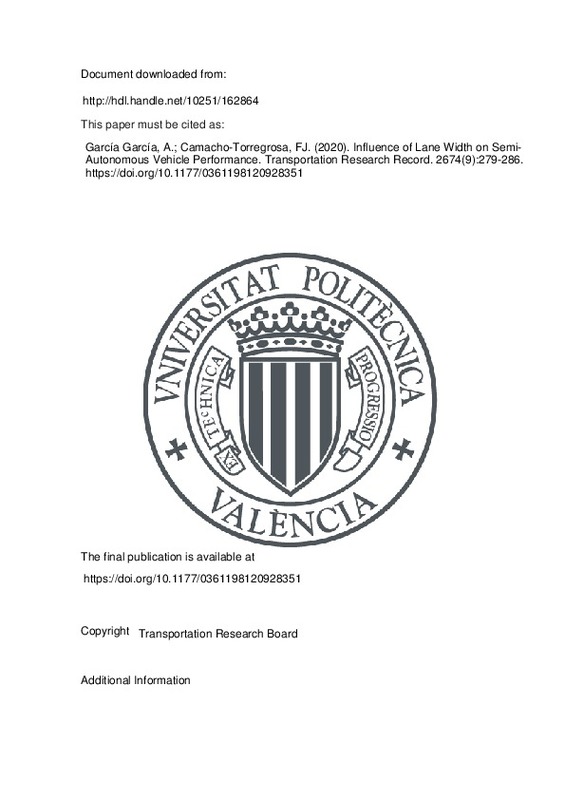JavaScript is disabled for your browser. Some features of this site may not work without it.
Buscar en RiuNet
Listar
Mi cuenta
Estadísticas
Ayuda RiuNet
Admin. UPV
Influence of Lane Width on Semi-Autonomous Vehicle Performance
Mostrar el registro sencillo del ítem
Ficheros en el ítem
| dc.contributor.author | García García, Alfredo
|
es_ES |
| dc.contributor.author | Camacho-Torregrosa, Francisco Javier
|
es_ES |
| dc.date.accessioned | 2021-03-03T04:31:58Z | |
| dc.date.available | 2021-03-03T04:31:58Z | |
| dc.date.issued | 2020-09 | es_ES |
| dc.identifier.issn | 0361-1981 | es_ES |
| dc.identifier.uri | http://hdl.handle.net/10251/162864 | |
| dc.description.abstract | [EN] In the medium-term, the number of semi-autonomous vehicles is expected to rise significantly. These changes in vehicle capabilities make it necessary to analyze their interaction with road infrastructure, which has been developed for human-driven vehicles. Current systems use artificial vision, recording the oncoming road and using the center and edgeline road markings to automatically facilitate keeping the vehicle within the lane. In addition to alignment and road markings, lane width has emerged as one of the geometric parameters that might cause disengagement and therefore must be assessed. The objective of this research was to study the impact of lane width on semi-autonomous vehicle performance. The automatic lateral control of this type of vehicle was tested along 81 lanes of an urban arterial comprising diverse widths. Results showed that the semi-autonomous system tended to fail on narrow lanes. There was a maximum width below which human control was always required-referred to as the human lane width-measuring 2.5 m. A minimum width above which automatic control was always possible-the automatic lane width-was established to be 2.75 m. Finally, a lane width of 2.72 m was found to have the same probability of automatic and human lateral control, namely the critical lane width. Following a similar methodology, these parameters could be determined for other vehicles, enhancing the interaction between autonomous vehicles and road infrastructure and thus supporting rapid deployment of autonomous technology without compromising safety. | es_ES |
| dc.language | Inglés | es_ES |
| dc.publisher | Transportation Research Board | es_ES |
| dc.relation.ispartof | Transportation Research Record | es_ES |
| dc.rights | Reserva de todos los derechos | es_ES |
| dc.subject.classification | INGENIERIA E INFRAESTRUCTURA DE LOS TRANSPORTES | es_ES |
| dc.title | Influence of Lane Width on Semi-Autonomous Vehicle Performance | es_ES |
| dc.type | Artículo | es_ES |
| dc.identifier.doi | 10.1177/0361198120928351 | es_ES |
| dc.rights.accessRights | Abierto | es_ES |
| dc.contributor.affiliation | Universitat Politècnica de València. Departamento de Ingeniería e Infraestructura de los Transportes - Departament d'Enginyeria i Infraestructura dels Transports | es_ES |
| dc.description.bibliographicCitation | García García, A.; Camacho-Torregrosa, FJ. (2020). Influence of Lane Width on Semi-Autonomous Vehicle Performance. Transportation Research Record. 2674(9):279-286. https://doi.org/10.1177/0361198120928351 | es_ES |
| dc.description.accrualMethod | S | es_ES |
| dc.relation.publisherversion | https://doi.org/10.1177/0361198120928351 | es_ES |
| dc.description.upvformatpinicio | 279 | es_ES |
| dc.description.upvformatpfin | 286 | es_ES |
| dc.type.version | info:eu-repo/semantics/publishedVersion | es_ES |
| dc.description.volume | 2674 | es_ES |
| dc.description.issue | 9 | es_ES |
| dc.relation.pasarela | S\417445 | es_ES |
| dc.description.references | Lu, Z., Zhang, B., Feldhütter, A., Happee, R., Martens, M., & De Winter, J. C. F. (2019). Beyond mere take-over requests: The effects of monitoring requests on driver attention, take-over performance, and acceptance. Transportation Research Part F: Traffic Psychology and Behaviour, 63, 22-37. doi:10.1016/j.trf.2019.03.018 | es_ES |
| dc.description.references | Dogan, E., Rahal, M.-C., Deborne, R., Delhomme, P., Kemeny, A., & Perrin, J. (2017). Transition of control in a partially automated vehicle: Effects of anticipation and non-driving-related task involvement. Transportation Research Part F: Traffic Psychology and Behaviour, 46, 205-215. doi:10.1016/j.trf.2017.01.012 | es_ES |
| dc.description.references | Shen, S., & Neyens, D. M. (2017). Assessing drivers’ response during automated driver support system failures with non-driving tasks. Journal of Safety Research, 61, 149-155. doi:10.1016/j.jsr.2017.02.009 | es_ES |
| dc.description.references | Du, X., & Tan, K. K. (2016). Comprehensive and Practical Vision System for Self-Driving Vehicle Lane-Level Localization. IEEE Transactions on Image Processing, 25(5), 2075-2088. doi:10.1109/tip.2016.2539683 | es_ES |
| dc.description.references | Du, X., & Tan, K. K. (2015). Vision-based approach towards lane line detection and vehicle localization. Machine Vision and Applications, 27(2), 175-191. doi:10.1007/s00138-015-0735-5 | es_ES |
| dc.description.references | Favarò, F., Eurich, S., & Nader, N. (2018). Autonomous vehicles’ disengagements: Trends, triggers, and regulatory limitations. Accident Analysis & Prevention, 110, 136-148. doi:10.1016/j.aap.2017.11.001 | es_ES |







![[Cerrado]](/themes/UPV/images/candado.png)

